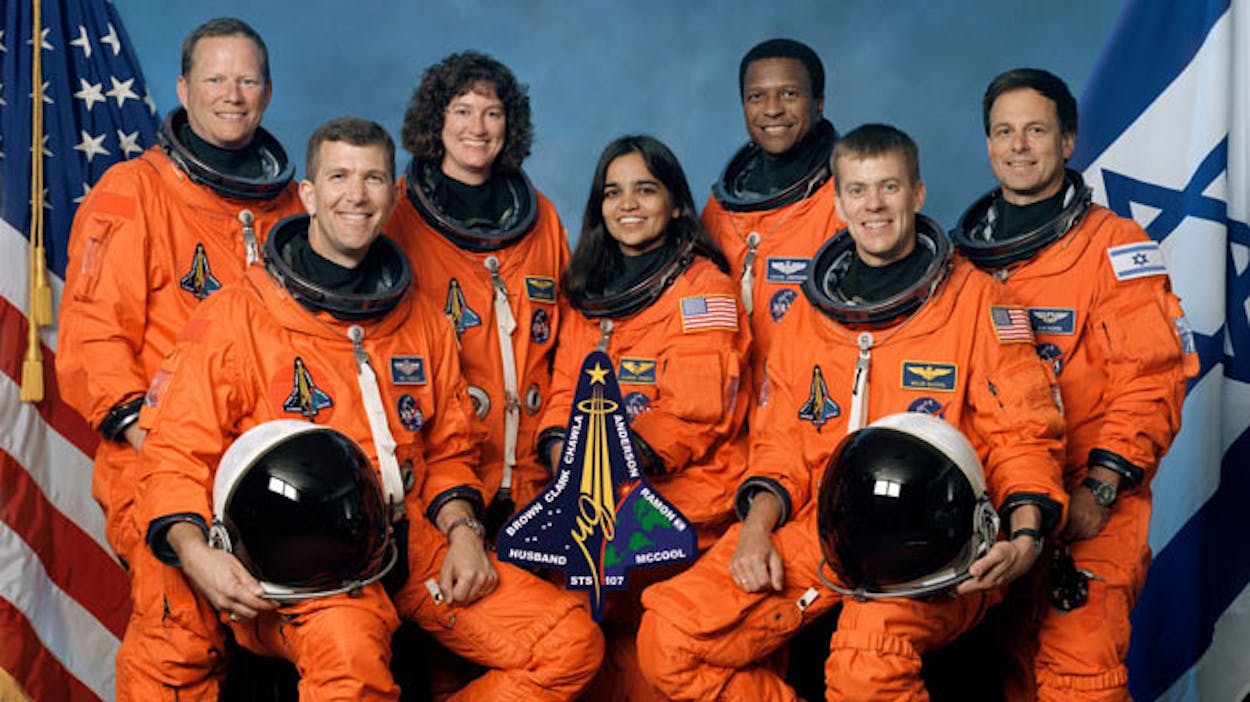Ten years ago today, on February 1, 2003, the Space Shuttle Columbia broke apart on reentry, streaking across the east Texas sky. All seven astronauts onboard, four of them making their first trip into space, would perish that day. Debris rained down over east Texas and west Louisiana. Thousands fanned out to recover what pieces of the doomed shuttle they could find, mounting what is now considered to be the largest search effort in human history. They ultimately collected some 84,000 pieces of Columbia debris, representing 39 percent of the shuttle’s total weight, from a 375-mile band stretching from Littlefield, Texas to Fort Polk, Louisiana.
The Columbia Accident Investigation Board determined that the accident’s immediate cause was a 1.7-pound piece of foam that dinged the spacecraft’s left wing 82 seconds after launch, letting superheated air enter the orbiter during reentry. In their final report, the board wrote that it “recognized early on that the accident was probably not an anomalous, random event, but rather likely rooted to some degree in NASA’s history and the human space flight program’s culture.”
In the April 2003 issue of Texas Monthly, Gary Borders, editor of the Nacogdoches Daily Sentinel, described both the “ineffable sadness” that descended over his east Texas city and the hum of activity that arose in paper’s newsroom in the wake of the disaster. “I recall turning to someone in the newsroom that day and saying, ‘I wish this had never happened. But remember that we will never cover a story like this again,'” he wrote. Stephen Harrigan, also writing in that issue, characterized the disaster this way: “The fate of Columbia was in some ways more like a shipwreck in the sky than anything we have encountered before in our sketchy catalog of space horrors. Unlike Challenger, Columbia did not blow up before it escaped the atmosphere, with its broken parts falling discreetly into the sea. Returning from space, it broke apart on the treacherous atmosphere like an oceangoing vessel splintering on a reef.”
Remembering Columbia in photos:
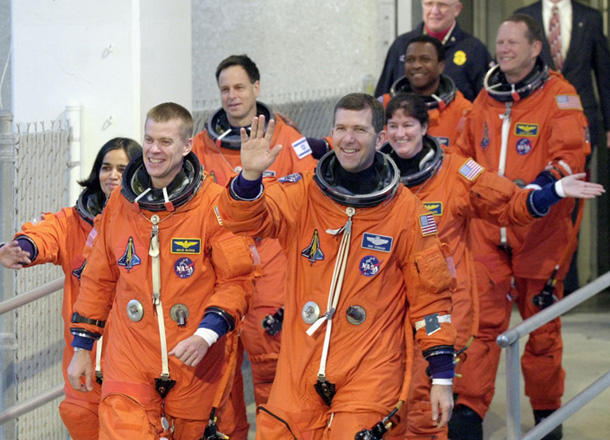 Commander Rick Husband, center, waves as he leads fellow space shuttle crew members, front row from left, Kalpana Chawla, William McCool, second row from left, Israeli astronaut Ilan Ramon, Laurel Clark, third row from left, Michael Anderson, and David Brown, from the Operations and Checkout Building early on the morning of launch January 16, 2003 at the Kennedy Space Center in Cape Canaveral, Florida. (AP Photo | Chris O’Meara)
Commander Rick Husband, center, waves as he leads fellow space shuttle crew members, front row from left, Kalpana Chawla, William McCool, second row from left, Israeli astronaut Ilan Ramon, Laurel Clark, third row from left, Michael Anderson, and David Brown, from the Operations and Checkout Building early on the morning of launch January 16, 2003 at the Kennedy Space Center in Cape Canaveral, Florida. (AP Photo | Chris O’Meara)
 The space shuttle Columbia clears the pad on way to orbit after liftoff at the Kennedy Space Center in Cape Canaveral, Florida on January 16, 2003. Shortly after Columbia lifted off, a piece of insulating foam on its external fuel tank came off and was believed to have hit the left wing of the shuttle. Leroy Cain, the lead flight director in Mission Control, assured reporters on January 31, 2003, that engineers had concluded that any damage to the wing was considered minor and posed no safety hazard. (AP Photo | Luis Alvarez)
The space shuttle Columbia clears the pad on way to orbit after liftoff at the Kennedy Space Center in Cape Canaveral, Florida on January 16, 2003. Shortly after Columbia lifted off, a piece of insulating foam on its external fuel tank came off and was believed to have hit the left wing of the shuttle. Leroy Cain, the lead flight director in Mission Control, assured reporters on January 31, 2003, that engineers had concluded that any damage to the wing was considered minor and posed no safety hazard. (AP Photo | Luis Alvarez)
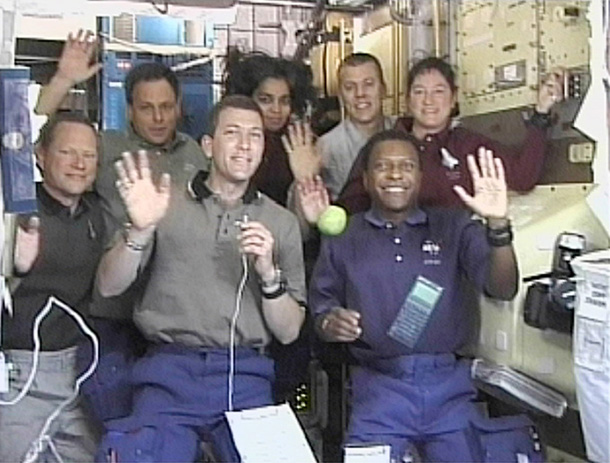 Astronauts aboard Columbia wave to a television camera as an apple floats in the foreground on January 20, 2003, four days into their flight. (AP Photo | NASA TV)
Astronauts aboard Columbia wave to a television camera as an apple floats in the foreground on January 20, 2003, four days into their flight. (AP Photo | NASA TV)
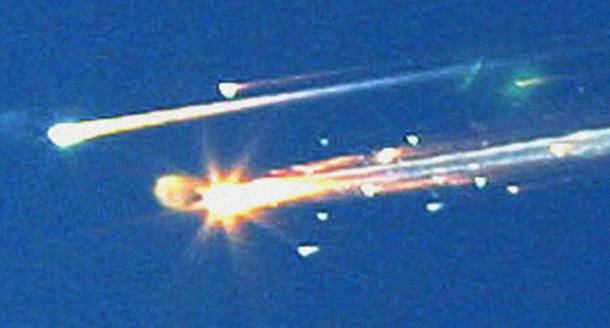 Debris from the space shuttle Columbia streaks across the sky over Tyler, Texas, Saturday, February 1, 2003. Amateur photographer Dr. Scott Lieberman shot a series of photos showing the break-up of the space shuttle from his backyard in Tyler early Saturday. (AP Photo | Dr. Scott Lieberman)
Debris from the space shuttle Columbia streaks across the sky over Tyler, Texas, Saturday, February 1, 2003. Amateur photographer Dr. Scott Lieberman shot a series of photos showing the break-up of the space shuttle from his backyard in Tyler early Saturday. (AP Photo | Dr. Scott Lieberman)
 Employees at John Eye Big Sandy Weekend Superstore in Princeton, West Virginia, watch as several televisions play back footage of the break-up of the space shuttle Columbia on Saturday, Feb. 1, 2003. (AP Photo | Bluefield Daily Telegraph, Eric DiNovo)
Employees at John Eye Big Sandy Weekend Superstore in Princeton, West Virginia, watch as several televisions play back footage of the break-up of the space shuttle Columbia on Saturday, Feb. 1, 2003. (AP Photo | Bluefield Daily Telegraph, Eric DiNovo)
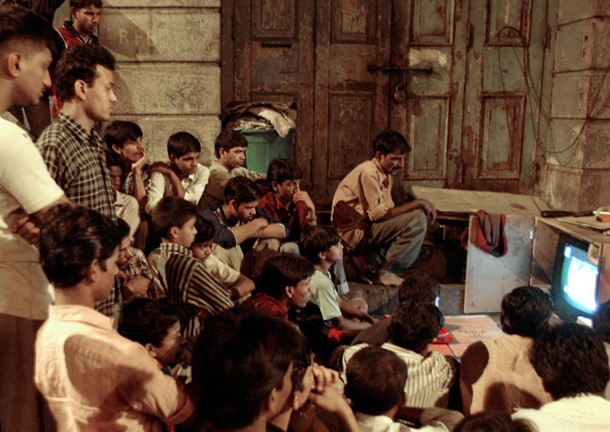 Indian slum dwellers gather in front of a television set to watch the news about the Space Shuttle Columbia in Mumbai, India on February 1, 2003. Indian-American Astronaut Kalpana Chawla was among the seven who perished in the accident. (AP Photo | Aijaz Rahi)
Indian slum dwellers gather in front of a television set to watch the news about the Space Shuttle Columbia in Mumbai, India on February 1, 2003. Indian-American Astronaut Kalpana Chawla was among the seven who perished in the accident. (AP Photo | Aijaz Rahi)
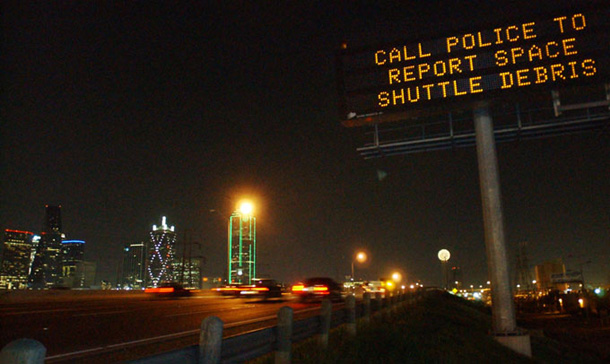 A road sign over Interstate 35 heading into downtown Dallas asks motorists to report any debris from the space shuttle Columbia to the authorities on February 1, 2003. (AP Photo | Tim Sharp)
A road sign over Interstate 35 heading into downtown Dallas asks motorists to report any debris from the space shuttle Columbia to the authorities on February 1, 2003. (AP Photo | Tim Sharp)
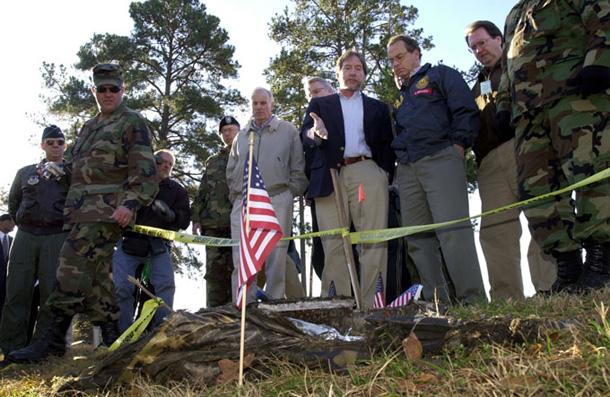 Admiral Harold W. Gehman Jr., fifth from left in beige jacket, and other officials view debris from the space shuttle Columbia near Nacogdoches on February 4, 2003. Gehman chaired the Columbia Accident Investigation Board that looked into the cause of the accident. (AP Photo | Eric Gay)
Admiral Harold W. Gehman Jr., fifth from left in beige jacket, and other officials view debris from the space shuttle Columbia near Nacogdoches on February 4, 2003. Gehman chaired the Columbia Accident Investigation Board that looked into the cause of the accident. (AP Photo | Eric Gay)
 Astronauts Mark Kelly, left, and Greg Johnson, center, leave a home near Nacogdoches, Texas, carrying debris from the space shuttle Columbia on the day of the disaster. (AP Photo | Tyler Morning Telegraph, D.J. Peters)
Astronauts Mark Kelly, left, and Greg Johnson, center, leave a home near Nacogdoches, Texas, carrying debris from the space shuttle Columbia on the day of the disaster. (AP Photo | Tyler Morning Telegraph, D.J. Peters)
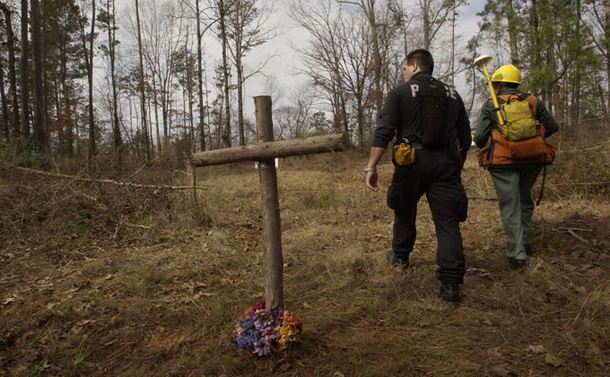 Searchers, some armed with GPS transceivers, pass a makeshift memorial while searching for debris from space shuttle Columbia on Sunday, February 2, 2003 outside Hemphill, Texas. The memorial marks the spot where remains of an astronaut were found the previous day. (AP Photo | David J. Phillip)
Searchers, some armed with GPS transceivers, pass a makeshift memorial while searching for debris from space shuttle Columbia on Sunday, February 2, 2003 outside Hemphill, Texas. The memorial marks the spot where remains of an astronaut were found the previous day. (AP Photo | David J. Phillip)
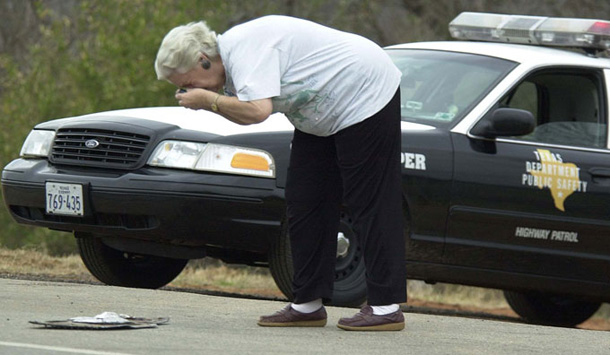 A woman photographs a piece of Space Shuttle debris on a rural road west of Nacogdoches, Texas two days after the tragedy. (AP Photo | LM Otero)
A woman photographs a piece of Space Shuttle debris on a rural road west of Nacogdoches, Texas two days after the tragedy. (AP Photo | LM Otero)
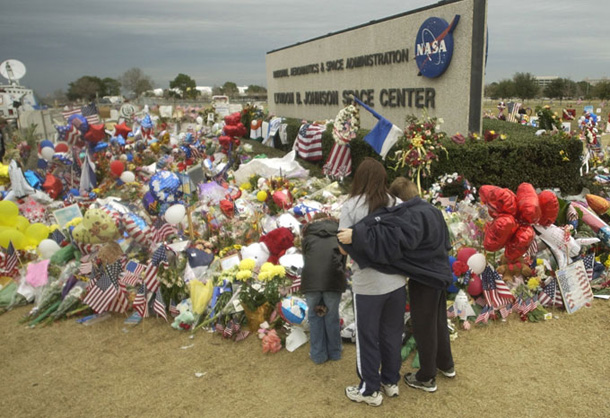 A family of mourners look over the growing makeshift memorial to the fallen shuttle astronauts at the entrance to the Johnson Space Center in Houston on February 5, 2003. As recovery teams scouted the east Texas woods for shuttle debris, the memorial at the gates of the space center continued to grow. (AP Photo | Joe Cavaretta)
A family of mourners look over the growing makeshift memorial to the fallen shuttle astronauts at the entrance to the Johnson Space Center in Houston on February 5, 2003. As recovery teams scouted the east Texas woods for shuttle debris, the memorial at the gates of the space center continued to grow. (AP Photo | Joe Cavaretta)
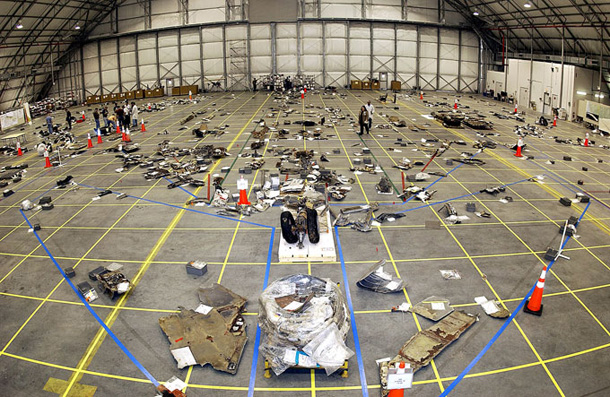 A wide angle elevated view of the space shuttle Columbia’s recovered wreckage is seen on the grid of this hangar at the Kennedy Space Center in Cape Canaveral, Florida in March 2003. Ultimately, more than 84,000 pieces of Columbia were recovered. While a water search of Lake Nacogdoches did not prove fruitful in 2003, the drought in 2011 revealed a tank from the shuttle on the lakebed. (AP Photo | NASA, Kim Shiflett)
A wide angle elevated view of the space shuttle Columbia’s recovered wreckage is seen on the grid of this hangar at the Kennedy Space Center in Cape Canaveral, Florida in March 2003. Ultimately, more than 84,000 pieces of Columbia were recovered. While a water search of Lake Nacogdoches did not prove fruitful in 2003, the drought in 2011 revealed a tank from the shuttle on the lakebed. (AP Photo | NASA, Kim Shiflett)
Aubrey Luce, of Bronson, Texas, holds a NASA space shuttle mission patch Aubrey Luce, of Bronson, Texas, holds a NASA space shuttle mission patch that he brought to a debris storage and sorting facility in Hemphill, Texas on February 7, 2003. (AP Photo | David J. Phillip)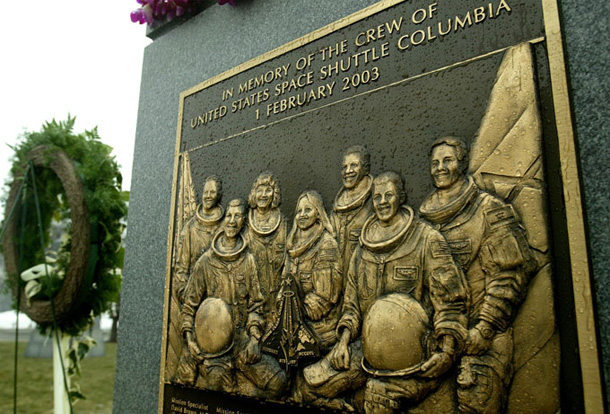 A new memorial to the crew of space shuttle Columbia is seen at Arlington National Cemetery in Arlington, Virginia in February 2004. The memorial, featuring a bronze replica of a mission patch designed by crew members, was dedicated in a closed ceremony a year and a day after the ship disintegrated on its return to earth, claiming the lives of all seven astronauts aboard. (AP Photo | Ron Edmonds)
A new memorial to the crew of space shuttle Columbia is seen at Arlington National Cemetery in Arlington, Virginia in February 2004. The memorial, featuring a bronze replica of a mission patch designed by crew members, was dedicated in a closed ceremony a year and a day after the ship disintegrated on its return to earth, claiming the lives of all seven astronauts aboard. (AP Photo | Ron Edmonds)

